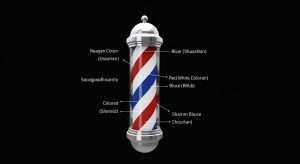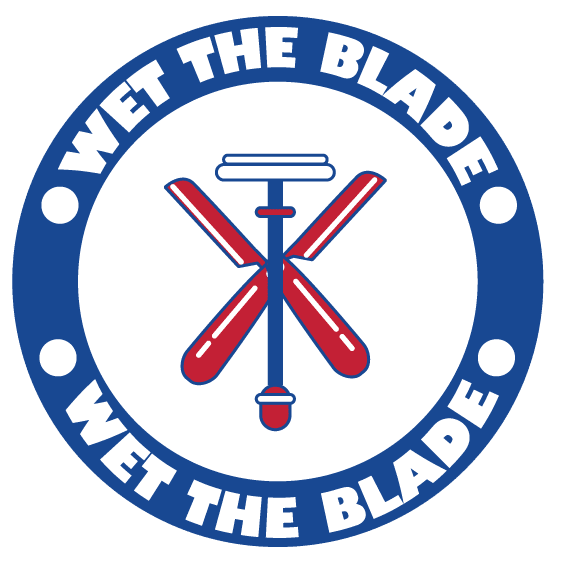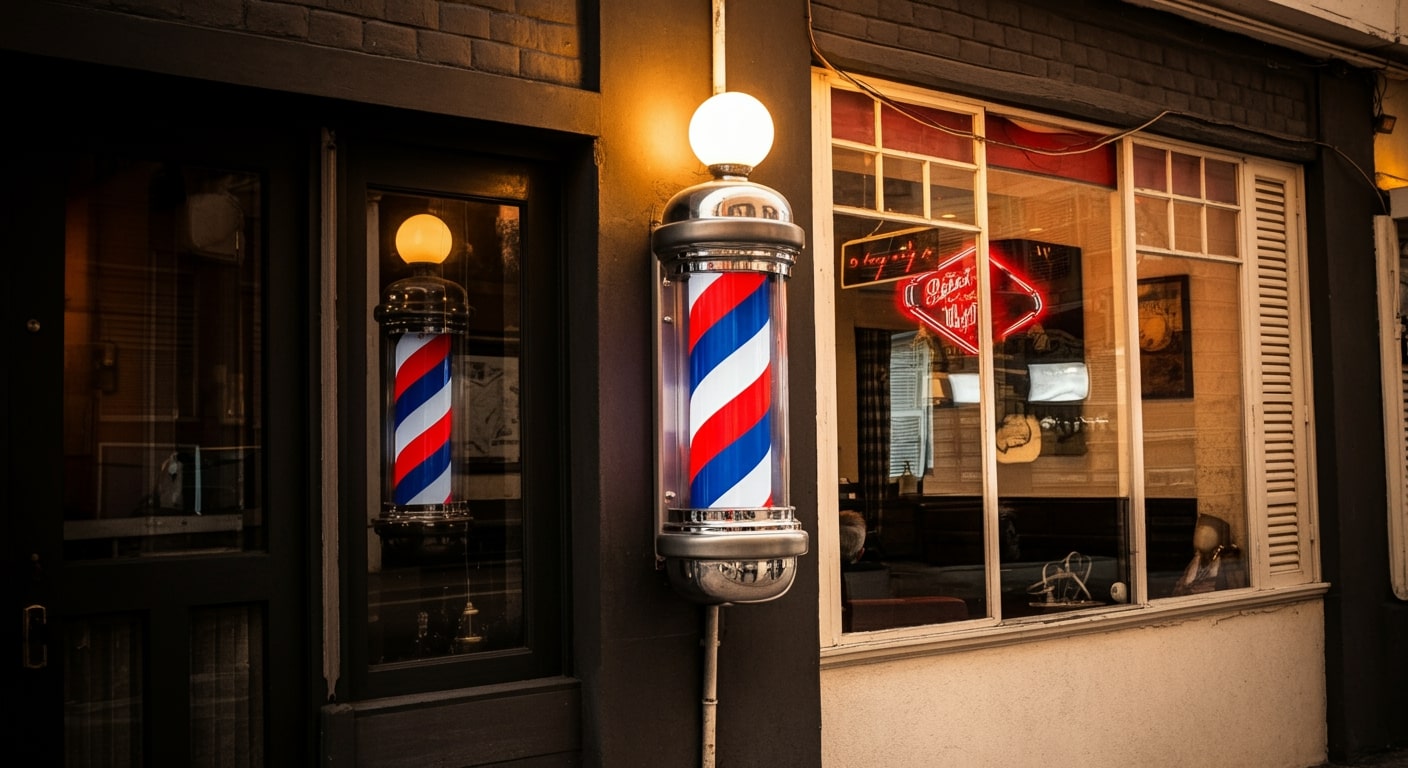The barber pole is an iconic item that automatically tells you right there, you have a barber that’s ready to assist you in getting a clean cut or shave. And while some people think that barber poles were invented in recent times, that’s not really the case. In this article we will focus on where did the barber pole originate, why it was created, and the history of barber pole colors.
It’s important for us to realize that barber poles are not just a randomly thrown together. They were an active piece of advertising, and they have been around for centuries on end. It’s not an item that ended up invented recently. Granted, while there were many iterations of the barber pole over the years, it’s always been a symbol of hygiene and cleanliness, one way or another. But when you learn what is the history of a barber pole, it will surely impress more than you might expect.
Where did the barber pole originate?
The origin of barber pole is actually quite interesting and macabre at the same time. During the middle ages, medical services weren’t really that clean, hygienic, or easy to do. People did not have the technology and methods that we have right now. So during that time, bloodletting was actually very common. And as the name suggests, it was basically the idea of cutting a vein open and allowing the blood to drain.
During that time, bloodletting was actually the main approach to treat a plethora of maladies, no matter if it was plague, or even something as simple as a sore throat. During those times, monks were the ones taking care of sick people. However, due to the different sharp instruments they were using, barbers would sometimes offer assistance and help. And that’s how they got involved into medical tasks.

The important thing to keep in mind here is that Pope Alexander III decided to prohibit clergymen from carrying bloodletting and other similar procedures. That happened in 1163, and because of that, barbers needed to handle this. Physicians existed at that time, but they saw this as a very menial thing to do. So yes, barbers started being the ones that tackled such a procedure.
It got to a point where barbers were also seen as surgeons, in a variety of different places. The history of barber pole colors stems from that as well. The red and white colors we see on barber poles right now represent a specific thing: white was the bandage use to stem the bleeding, while red was actually the blood that ended up on the bandages as people got treated. And on top of that, barbers used to try and dry out the bandages after they were cleaned, yet they still had some blood on them. So they added these to the pole near or in front of their business. And that’s how was the barber pole invented. It’s a very distinctive and different thing for sure, but it clearly shows how the barber poles started to exist, and why they had this color.
Another take on the barber poles
We should also note that for a lot of people during those medieval times, the pole itself was also a symbol for the stick that patients were squeezing in order to make their arm’s veins stand out. If you check the European barber poles, those were only red and white, as we explained earlier. The American ones also had blue.
What does blue represent in these American barber poles? To make it easier to understand, blue was a symbol of the veins that got cut during bloodletting. However, there are also people which state that blue was actually a sign of patriotism and it had nothing to do with the procedure itself. It was safe to say that figuring out all this information was not easy to do, but it did give a lot of info when it comes to how challenging the procedure was, especially in a world without great technology.
We can safely say that barbers had to use these rather primitive tools to save lives, plus at the time, no one was really doing this type of work anyway. So they got pretty much forced to do this type of stuff, and it wasn’t easy for them. But it did allow them to bring in more clients, albeit for a different reasons rather than just getting a haircut or for shaving their beards.
Did barbers get banned from performing surgeries?
Eventually, as the society evolved and medical services started getting better, things changed. That was especially true after the Plague passed and people started taking hygiene and health more seriously. There were still plenty of issues to deal with at the time, but for the most part, people realized that barbers shouldn’t be the ones handling or even more so, performing surgeries.
So it was around the mid-1500s when barbers in England were banned from performing any type of surgery. However, they were still allowed to tackle certain medical tasks that were less intrusive. For example, a barber would be allowed to extract teeth. Yet we also need to note the fact that surgeons and barbers remained in the same trade guild until things were changed, but that happened in 1745. So it was a very long time when barbers were doing a lot of medical tasks, and in some regions, it even got into the 1800s, especially in Americas and remote places within the country.
Barbers taking the role of a surgeon quickly fell out of fashion after that. In fact, in England the last barber surgeon died in 1821 and since then there was no barber with a dual-purpose like they once were. However, the history behind the barber pole clearly shows barber served a plethora of roles over the years. And it’s a clear indicator that barbers always had a major role when it came to history and how pivotal of a role they had for centuries.
Yet things changed, and within the last 200-250 years, barbers only focused on the tasks we know today. But as we can see, the barber pole itself is a clear indicator of those times long gone, when people were tackling things with a much different idea and perspective!
Why did the barber pole colors stay this way for a very long time?
It depends on the perception and the times that we want to cover. For example, barber poles were a significant way for barbers to show the type of services that they were offering. Because they were indeed handling a lot of surgeries and messy tasks like that during the medieval times. In fact, the red and white symbolize the clean and bloody bandages that they were using for medical procedures.

It became so common for barbers to do this type of work that in the 17th century they actually started forming their own guilds of barber surgeons. And that’s when the barber pole became a symbol. It was a way for them to advertise their services. It also showed that the barber would provide a variety of other services, not just something simple. And in the end, it did manage to bring in a much better and more cohesive perspective when it came to how they were offering these services.
In addition to that, when a barber surgeon started being a part of a guild, the pole was a public sign to show the type of work the barber was doing, along with how legitimate their business was. Because at the time, being a part of a barber surgeon guild was a way to show legitimacy. Others from the same guild trusted them to deliver such services, and it was a sign to showcase the value they could provide and how others would trust them in the first place.
Why did the surgeons and barbers separate?
Around the 1800s, as we mentioned earlier, a separation started to appear between barbers and surgeons. Until that time, the same people were doing these jobs, but eventually, new medical science advancements started to appear. At that point, it was clear that some people would focus more on medical tasks and science, while others will just stick with the regular barber tasks.
And that’s when it split, with barbers focusing more on hair related services. Surgeons were focused on medical procedures, and now customers would have specialized services to fit their requirements. It was the best approach, because to be realistic, barbers were not doctors. They were using very primitive methods to help people alleviate pain and deal with it. But as time went by and the medical world evolved, it was clear that advanced medical solutions were needed. Older, medieval, deprecated methods were a thing of the past and would not help people, which is why they had to try out something new and different.
What’s the modern symbolism of a barber pole?
It depends on the situation, but right now, people still connect the barber pole to the older representation of having bandages wrapped around a pole to have them clean and tidy. Sure, barbers these days are not offering that type of services anymore, but for a lot of people, it just doesn’t matter. People are always trying to find new, creative ways to improve their looks, and a barber can help with that.
While the older significance of barber poles has faded, the visuals are still there. Since the red and white symbol has been used for so many centuries, people are not going away from that. Instead, they retain that unique symbolism, which is what sets these poles apart, and that just goes to show the unique perspective that these barber poles have in the first place.

Granted, those old school methods and tools are not the same, and the industry has evolved. Yet in the end, the history of the profession is appreciated and respected by the modern barber poles. They are moving around, they have great visuals, but at the same time, they appreciate the old history of the business and how it shaped everything into what barbers do today. Yes, it is a very rich history, and paying respect to that is certainly a game changing approach!
Why are American barber poles red, white and blue?
What we notice is that in the US, these barber poles are very different when it comes to the colors. Instead of just the red and white which obviously have their own meaning, the American barber poles also added in blue. What a lot of people don’t know is the fact that the original barber pole was a brass basin that had the vessel where leeches were kept and also the basin where the blood was received.
Americans started adding their own ideas for barber poles, and in this case, it was more about the idea of integrating their own representation. Some are saying that the blue here is symbolizing the venous blood, while others think it has to do specifically with the statute that people have and that it was meant to be a service used mostly by aristocrats, quite interesting and different when compared to the European representation of a barber pole. Even though that was just as interesting and unique in its own right.
Conclusion
It’s extremely important for everyone to realize that barbers have always been focused on offering comprehensive, great and professional services. They’ve played a dual role for centuries, even if people don’t realize that. And while they did switch gears during the 1800s, there’s no denying that barber poles and the history of this industry continues to pay homage to the old days. Which is great, because it means people always remember where they come from, and they are respectful of the past. It’s an exciting venture, and one that barbers appreciate and focus on with great pride. Which is exactly what sets them apart from many other industries!

